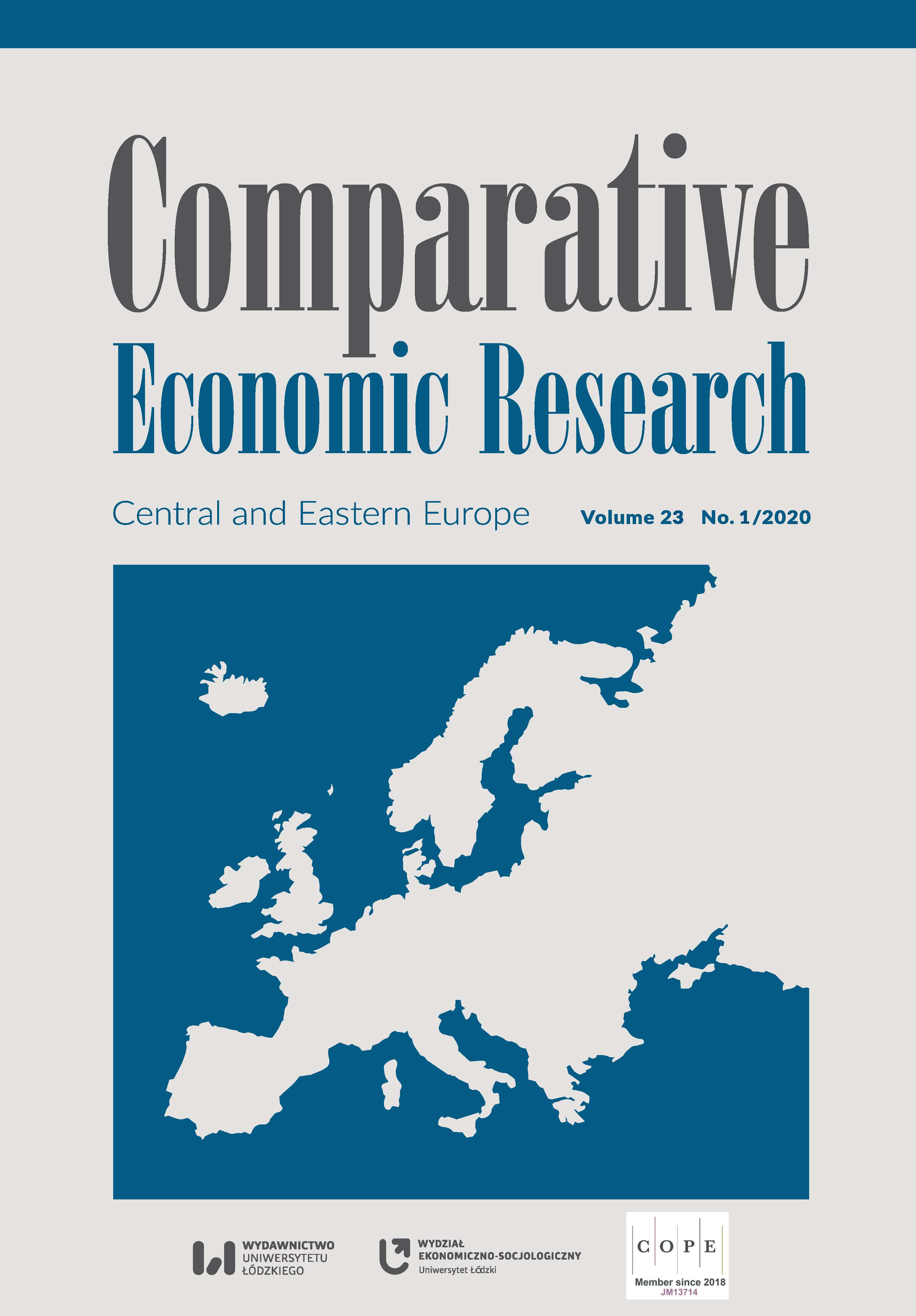Mercosur – a Comparison of Four Member Countries on the Basis of Selected Economic Indicators
DOI:
https://doi.org/10.18778/1508-2008.23.04Keywords:
Mercosur, cluster analysis, country comparison, regional integrationAbstract
The aim of this paper is to present how countries can be compared on the basis of the development of selected macroeconomic indicators. The economic similarity of the four founding Mercosur countries (i.e., Argentina, Brazil, Paraguay, and Uruguay), based on the development of five selected macroeconomic indicators in the period 1991–2016, is investigated. The following indicators were analyzed: current account balance, GDP per capita, trade-to-GDP ratio, unemployment rate, and the GDP deflator, using data from the World Bank database. Using hierarchical cluster analysis of changes in time series (differences and growth rates), it was found that the obtained clusters of countries are different. For this reason, cluster analysis was carried out for two different groups of indicators on the basis of the averages of the Euclidean distances obtained for the individual indicators.
Downloads
References
Arias, J.C. (2008), Asimetrías en el Mercosur: Un Enfoque Macroeconómico. V: Asimetrías en el Mercosur: ¿Impedimento para el Crecimiento?, Red Mercosur, Montevideo, pp. 31–85.
Google Scholar
Baer, W., Cavalcanti, T., Silva P. (2002), Economic integration without policy coordination: the case of Mercosur?, “Emerging Market Review”, Vol. 3, No. 2002, pp. 269–291. https://doi.org/10.1016/S1566-0141(02)00025-0
Google Scholar
Basnet, H.C., Pradhan, G. (2017), Regional economic integration in Mercosur: The role of real and financial sectors, “Review of Development Finance”, Vol. 7, No. 2, pp. 107–119. https://doi.org/10.1016/j.rdf.2017.05.001
Google Scholar
Campos, G.L. (2016), From success to failure: Under what conditions did Mercosur integrate?, “Journal of Economic Integration”, Vol. 31, No. 4, pp. 855–897. https://doi.org/10.11130/jei.2016.31.4.855
Google Scholar
Cardoso Ferraz, F. (2013), Crise Financeira Global: Impactos na Economia Brasileira, Política Econômica e Resultados [online]. Master thesis at Universidade Federal do Rio de Janeiro, Rio de Janeiro. http://www.ie.ufrj.br/images/pos-graducao/ppge/FernandoFerraz.pdf (accessed: 22.03.2019).
Google Scholar
CEPAL (2009), Infraestructura física e integración regional, “Boletín FAL”, No. 280, pp. 1–4.
Google Scholar
Da Silva, O.M., Batista, J.S. (2015), Uma avaliação da similaridade e da sofisticação das exportações dos países do Cone Sul, “Análise Econômica”, Vol. 33, No. 64, pp. 243–264. https://doi.org/10.22456/2176-5456.42005
Google Scholar
De Almeida, P.R. (2018), Regional Integration in Latin America: Historical Developments, Current Challenges, Especially in Mercosur. https://papers.ssrn.com/sol3/papers.cfm?abstract_id=3182150 (accessed: 27.11.2019).
Google Scholar
Gomes, G., Silva da Cruz, C.A. (2017), Vinte Anos de Economia Brasileira [online]. Centro de Altos Estudos Brasil Século XXI , Brasília. http://www.altosestudosbrasilxxi.org.br (accessed: 18.11.2018).
Google Scholar
Khan, S. (2008), Regional Trade Integration and Conflict Resolution, 1st ed., International Research Development Center, Ottawa. https://doi.org/10.4324/9780203889800
Google Scholar
Kritzinger, L. (2015), Regional Integration: Concepts, Advantages, Disadvantages, and Lessons of Experience [online]. World Bank Policy Paper. http://siteresources.worldbank.org/EXTAFRREGINICOO/Resources/Kritzinger.pdf (accessed: 22.07.2018).
Google Scholar
Kugiel, P., Cooray, S., Wickramaratne, T. (2013), Benefits of regional integration: What Sri Lanka can learn from Poland, “PISM Policy Paper”, No. 25 (73), pp. 2–8.
Google Scholar
Liao, T.W. (2005), Clustering of time series data – a survey, “Pattern Recognition”, Vol. 38, No. 11, pp. 1857–1874. https://doi.org/10.1016/j.patcog.2005.01.025
Google Scholar
Ministério da Fazenda (2017), Balanço de Pagamentos [online]. Secretaria de Politica Econômica Janeiro, Brasília. http://www.altosestudosbrasilxxi.org.br (accessed: 17.02.2018).
Google Scholar
Mukhametdinov, M. (2019), Mercosur and the European Union, Palgrave Macmillan, Cham. https://doi.org/10.1007/978-3-319-76825-0
Google Scholar
Parrado, E.A., Cerrutti, M. (2003), Labor migration between developing countries: The case of Paraguay and Argentina, “International Migration Review”, Vol. 37, No. 1, pp. 101–132. https://doi.org/10.1111/j.1747-7379.2003.tb00131.x
Google Scholar
Peluffo, P. (2013), Assessing labor market impacts of trade opening in Uruguay, “SpringerPlus”, Vol. 2, No. 1, p. 219. https://doi.org/10.1186/2193-1801-2-219
Google Scholar
Porta, F. (2008), La Integración Sudamericana en Perspectiva. Problemas y Dilemas. Documento de Proyecto, CEPAL, Santiago de Chile.
Google Scholar
Roudil, H.R. (2006), Empleo y Desempleo en los Países Mercosur y Chile [online] http://www.relacionesdeltrabajo.fsoc.uba.ar/docs/002-roudil.pdf (accessed: 20.02.2019).
Google Scholar
Secretaria de Planejamento e Assuntos Econômicos (2017), Crise Econômica e Recuperação: Comparativo EUA e BRA [online] http://www.planejamento.gov.br/publicacoes/estudos-economicos/170925-seplan-nota-tecnica-pib-e-a-dinamica-da-crise-v2.pdf (accessed: 22.07.2018).
Google Scholar
SELA (2014), Evolución del Mercado Común del Sur (Mercosur), document SP/Di No. 6–14, SELA, Caracas.
Google Scholar
Schiff, M., Winters, L. (2003), Regional Integration and Development, The World Bank, Washington, D.C. https://doi.org/10.1596/0-8213-5078-1
Google Scholar
The World Bank (2018), Data Catalog [online] https://datacatalog.worldbank.org/dataset/world-development-indicators (accessed: 22.07.2018).
Google Scholar
Zanchetta Borghi, R.A. (2017), The Brazilian productive structure and policy responses in the face of the international economic crisis: An assessment based on input-output analysis, “Structural Change and Economic Dynamics”, Vol. 43, pp. 62–75. https://doi.org/10.1016/j.strueco.2017.08.001
Google Scholar
Downloads
Published
How to Cite
Issue
Section
License

This work is licensed under a Creative Commons Attribution-NonCommercial-NoDerivatives 4.0 International License.











